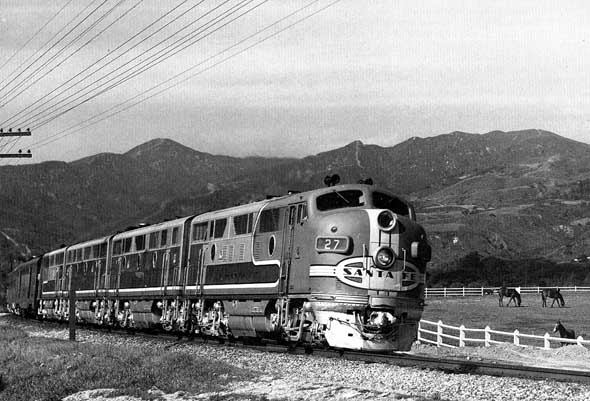|
The 16 class remained in passenger service until the late 1960's when some became surplus and these were demoted to freight service and spent their last miles working branchline freights mixed with freight F's and geeps. When Amtrak took over passenger service the surviving 16 class that were still in passenger service were renumbered into the 300 class. The rest of the A-units were rebuilt into CF-7's while F3B's were sold or traded in. All passenger F3's not renumbered were off the roster by the end of 1972, Several HO F3 models have been available over the years, the latest being Stewart's plastic import in several variations. Their "Phase I" F3 is useful for the as- delivered appearance of Santa Fe units 16LABC through 21LABC. It is available factory painted in Santa Fe passenger colors with a superb paint job. Except for air horns that might have been better, the model is excellent in all respects. Stewart's "Phase II" F3 would be used for those same units that were rebuilt with that style carbody for a brief time in the late 1940's. This model is not available factory painted in Santa Fe colors, but the undecorated version could be painted and decaled in the Santa Fe passenger scheme with little problem. Both the "Phase I and "Phase II" appearance were very short lived on Santa Fe F3's, "Phase I" only in 1946-48 and "Phase II" proably no later than 1951. Stewat's passenger F3's are available in both A and B units. Hallmark imported a brass "Phase I" F3 in early 1970's and it would also do for the very early 16 class-as-delivered. These models had a mechanism similar to that previously described for the FT's. They ran well, but were very noisy. Model Power makes a plastic "Phase I" F3A that has a fairly good body casting, but a poor mechanism. It could be a starting point for a rebuild and detailing project, but with Stewart's fine units being available, why bother with the Model Power F3 unless you are simply looking for a project for a project to work on? One of the first plastic HO models was the Varney F3. It was produced as a metal casting when it was originally introduced, later converted to plastic. Very crude by today's standards, it introduced a lot of modelers to HO scale however. Cary also produced a cast metal F3 shell that could be built up into a very accurate F3, but I am uncertain if it is still available. Santa Fe's late 16 class would probably be better modeled starting with either the Stewart or Athern F7 as their late appearance was much closer to an F7 than to the classic early F3. The biggest problem would be in the D/B and stainless steel grilles. The D/B fan could be replaced with the F-3 slit type D/B from a Highliner B-unit kit. Highliner raised cooling fans could also be used for modeling rebuilt early 16 class units. Stainless steel grilles on most 16 class units were of the vertical slit type rather than the horizontal type found on the Stewart and Athern F7's. Detail Associates has a very nice vertical slit stainless steel grille for E-units available and this can be shortened and installed on F-units to give the correct appearance. |
 Santa Fe's second batch of F3's received stainless steel side panels along the bottom of the carbody and one panel on the second row at the end. The rest of the side panels were painted to simulate stainless steel. Number 27 illustrates this pattern and the as-delivered lower headlight and shortened warbonnet of units 22-29. Units still have their "chicken wire" screens over the air intakes. Photograph was probably made soon after delivery in 1948 somewhere on Raton Pass. -Santa Fe, John McCall Collection |







